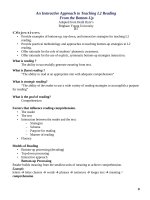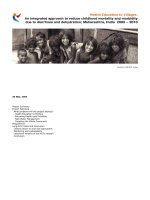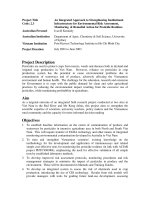An Integrated Approach to Teaching Literature in the EFL Classroom
Bạn đang xem bản rút gọn của tài liệu. Xem và tải ngay bản đầy đủ của tài liệu tại đây (77.95 KB, 5 trang )
An Integrated Approach to Teaching
Literature in the EFL Classroom
Christine Savvidou
This article considers the reasons why teachers often regard literature as inappropriate to
the language classroom. These views reflect the historic separation between the study of
language and the study of literature, which has led to the limited role of literature in the
language classroom. However, the use of literary texts can be a powerful pedagogic tool.
This article describes various approaches to teaching literature and provides a rationale for
an integrated approach to teaching literature in the language classroom based on the
premise that literature is language and language can indeed be literary.
Introduction
As teachers of English as a Foreign Language our main concern is to help learners acquire
communicative competence. For this reason we tend to focus on teaching standard forms of
linguistic expression. However, despite acquiring linguistic accuracy, it is apparent that
EFL speakers still have difficulties in comprehending the nuances, creativity and versatility
which characterise even standard and transactional forms of English, as these humorous
public notices demonstrate:
• We take your bags and send them in all directions. – Copenhagen airline ticket
office
• Would you like to ride on your own ass? – Advertisement for donkey rides in
Thailand
• You are invited to take advantage of the chambermaid. – Japanese hotel
( />Communicative competence is more than acquiring mastery of structure and form. It also
involves acquiring the ability to interpret discourse in all its social and cultural contexts.
For this reason, the use of literature in the EFL classroom can provide a powerful
pedagogic tool in learners’ linguistic development.
Focusing on Literature
Language, both spoken and written, comes in a variety of discourse types and, as teachers
of language, we attempt to introduce our learners to as many of these as possible.The
variety and types of discourse are perhaps best represented by Kinneavy’s communication
triangle (1983). This classification of discourse types includes expressive, which focuses
on personal expression (letters, diaries, etc.); transactional, which focuses on both the
reader and the message (advertising, business letters, editorials, instructions, etc.); and
poetic, which focuses on form and language (drama, poetry, novels, short stories, etc.).
Indeed, all these discourse types already play a significant role in teaching various aspects
of language such as vocabulary and structure, or testing learners’ comprehension.
However, there is often reluctance by teachers, course designers and examiners to
introduce unabridged and authentic texts to the EFL syllabus. There is a general perception
that literature is particularly complex and inaccessible for the foreign language learner and
can even be detrimental to the process of language learning (Or, 1995). Indeed, it is
difficult to imagine teaching the stylistic features of literary discourse to learners who have
a less than sophisticated grasp of the basic mechanics of English language. This perception
is also borne out by research (Akyel and Yalçin, 1990) which shows that the desire to
broaden learners’ horizons through exposure to classic literature usually has disappointing
results. The reasons why teachers often consider literature inappropriate to the language
classroom may be found in the common beliefs held about literature and literary language.
Firstly, the creative use of language in poetry and prose often deviates from the
conventions and rules which govern standard, non-literary discourse, as in the case of
poetry where grammar and lexis may be manipulated to serve orthographic or phonological
features of the language. Secondly, the reader requires greater effort to interpret literary
texts since meaning is detached from the reader’s immediate social context; one example is
that the “I” in literary discourse may not be the same person as the writer.
The result is that the reader’s “interpretative procedures” (Widdowson, 1975) may become
confused and overloaded. What this means is that the reader has to infer, anticipate and
negotiate meaning from within the text to a degree that is not required in non-literary
discourse. Thus, in our efforts to teach our learners’ communicative competence there is a
tendency to make use of texts which focus on the transactional and expressive forms of
writing with the exclusion or restriction of poetic forms of language – i.e. literature. There
is a perception that the use of literary discourse deflects from the straightforward business
of language learning, i.e. knowledge of language structure, functions and general
communication.
Why Teach Literature in the Language Classroom?
The classification of discourse types in this way would seem to suggest that there are
distinct differences between literary and non-literary discourse. This reflects a historic
divergence between language and literature, which Short (1996) refers to as a ‘border
dispute over territory’ between linguists and literary critics. This divergence has resulted in
the teaching of the two subjects as ‘disconnected pedagogic practices’ (Carter and McRae,
1996: xxiv). This is not to say there is no difference between literary and non-literary
discourse; however, Carter and Nash (1990) suggest that rather than perceiving literary
discourse as separate and remote from non-literary discourse, we ought to consider the
variety of text types along a continuum with some being more literary than others. This
view is part of the idea that the separation of literature from language is a false dualism
since literature is language and language can indeed be literary. It is not difficult to find
instances of standard transactional forms of discourse which make use of a whole array of
literary devices. Headlines and advertisements are common examples of discourse which
exploits literary language. The following examples make explicit use of alliteration,
assonance, register, imagery, ellipsis and rhythm - stylistic devices which are more
commonly associated with literature than with standard, transactional language.
• Headline: King Khan Goes for Gold (The Scotsman, 28.08.2004)
• Headline: Bookies' bonanza comes at a price (The Scotsman, 28.08.2004)
• Advertisement: You'll never put a better bit of butter on your knife - Country Life
butter
• Advertisement: Have a break, have a Kit Kat - Kit Kat chocolate
• Advertisement: Put a tiger in your tank – ESSO
The boundaries which are thought to exist between literary and non-literary discourse are
not so distinct. Indeed, as Widdowson (1979) suggests, the procedures which are used to
interpret literary discourse are essentially the same for interpreting any type of discourse.
Approaches to Teaching Literature
Having decided that integrating literature into the EFL syllabus is beneficial to the learners’
linguistic development, we need to select an approach which best serves the needs of EFL
learners and the syllabus. Carter and Long (1991) describe the rationale for the use of the
three main approaches to the teaching of literature:
The Cultural Model
This model represents the traditional approach to teaching literature. Such a model requires
learners to explore and interpret the social, political, literary and historical context of a
specific text. By using such a model to teach literature we not only reveal the universality
of such thoughts and ideas but encourage learners to understand different cultures and
ideologies in relation to their own. This model is largely rejected by those in TEFL since
not only does it tend to be teacher-centred but there is little opportunity for extended
language work.
The Language Model
The most common approach to literature in the EFL classroom is what Carter and Long
(1991) refer to as the ‘language-based approach’. Such an approach enables learners to
access a text in a systematic and methodical way in order to exemplify specific linguistic
features e.g. literal and figurative language, direct and indirect speech. This approach lends
itself well to the repertoire of strategies used in language teaching - cloze procedure,
prediction exercises, jumbled sentences, summary writing, creative writing and role play -
which all form part of the repertoire of EFL activities used by teachers to deconstruct
literary texts in order to serve specific linguistic goals. Carter and McRae (1996) describe
this model as taking a ‘reductive’ approach to literature. These activities are disconnected
from the literary goals of the specific text in that they can be applied to any text. There is
little engagement of the learner with the text other than for purely linguistic practice;
literature is used in a rather purposeless and mechanistic way in order to provide for a
series of language activities orchestrated by the teacher.
The Personal Growth Model
This model attempts to bridge the cultural model and the language model by focusing on
the particular use of language in a text, as well as placing it in a specific cultural context.
Learners are encouraged to express their opinions, feelings and opinions and make
connections between their own personal and cultural experiences and those expressed in
the text. Another aspect of this model is that it helps learners develop knowledge of ideas
and language – content and formal schemata – through different themes and topics. This
function relates to theories of reading (Goodman, 1970) which emphasise the interaction of
the reader with the text. As Cadorath and Harris point out (1998:188) "text itself has no
meaning, it only provides direction for the reader to construct meaning from the reader's
own experience". Thus, learning is said to take place when readers are able to interpret text
and construct meaning on the basis of their own experience.
These three approaches to teaching literature differ in terms of their focus on the text:
firstly, the text is seen as a cultural artefact; secondly, the text is used as a focus for
grammatical and structural analysis; and thirdly, the text is the stimulus for personal growth
activities. What is needed is an approach to teaching literature in the EFL classroom which
attempts to integrate these elements in a way that makes literature accessible to learners
and beneficial for their linguistic development.
Rationale for an Integrated Model for Teaching
Literature
According to Duff and Maley (1990), the main reasons for integrating these elements are
linguistic, methodological and motivational. Linguistically, by using a wide range of
authentic texts we introduce learners to a variety of types and difficulties of English
language. Methodologically, literary discourse sensitises readers to the processes of
reading e.g. the use of schema, strategies for intensive and extensive reading etc. And,
lastly, motivationally, literary texts prioritise the enjoyment of reading since, as Short and
Candlin assert (1986), ‘if literature is worth teaching...then it seems axiomatic that it is the
response to literature itself which is important’. Interpretation of texts by learners can bring
about personal responses from readers by touching on significant and engaging themes. An
integrated model is a linguistic approach which utilises some of the strategies used in
stylistic analysis, which explores texts, literary and non-literary, from the perspective of
style and its relationship to content and form. This involves the systematic and detailed
analysis of the stylistic features of a text – vocabulary, structure, register etc. in order to
find out ‘not just what a text means, but also how it comes to mean what it does’ (Short,
1996). This suggested model (O’Brien, 1999) integrates linguistic description with
interpretation of the text although for the benefit of the foreign language learners it is not as
technical, rigorous or analytical as the stylistics approach. With the careful selection of the
text, it can be adapted for all levels.
Stage 1: Preparation and Anticipation
This stage elicits learners’ real or literary experience of the main themes and context of
text.
Stage 2: Focusing
Learners experience the text by listening and or reading and focusing on specific content in
the text.
Stage 3: Preliminary Response
Learners give their initial response to the text - spoken or written
Stage 4: Working at it - I
Focus is on comprehending the first level of meaning through intensive reading.
Stage 5: Working at it - II
Focus is on analysis of the text at a deeper level and exploring how the message is
conveyed through overall structure and any special uses of language - rhythm, imagery,
word choice etc.
Stage 6: Interpretation and Personal Response
The focus of this final step is on increasing understanding, enhancing enjoyment of the text
and enabling learners to come to their own personal interpretation of the text. This is based
on the rationale for the personal growth model.
Conclusion
There are many benefits to using literature in the EFL classroom. Apart from offering a
distinct literary world which can widen learners’ understanding of their own and other
cultures, it can create opportunities for personal expression as well as reinforce learners’
knowledge of lexical and grammatical structure. Moreover, an integrated approach to the
use of literature offers learners strategies to analyse and interpret language in context in
order to recognize not only how language is manipulated but also why. An integrated
approach to the use of literature in the language classroom offers foreign language learners
the opportunity to develop not only their linguistic and communicative skills but their
knowledge about language in all its discourse types. The use of literary texts in the
language classroom can be a potentially powerful pedagogic tool.







